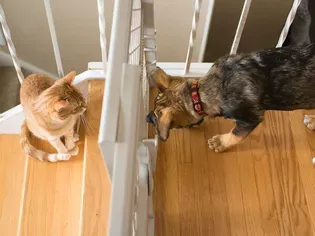How to Introduce a Cat to a Dog
Updated on 04/26/24

Headline: Harmony in the House: A Comprehensive Guide to Introducing a Cat to a Dog
Introduction:
Welcoming a new pet into your home is an exciting yet daunting experience, especially when that pet is a furry feline joining a canine companion. The prospect of introducing a cat to a dog can send shivers down the spine of even the most seasoned pet owners. However, with patience, preparation, and the right approach, you can create a harmonious household where these two seemingly different species can coexist peacefully.
Understanding the Differences:
Before embarking on the introduction process, it's crucial to acknowledge the fundamental differences between cats and dogs. Cats are solitary creatures that prize their independence, while dogs are social pack animals that crave interaction. Their disparate communication styles, body language, and territorial instincts can make the initial meeting a potential clash of cultures.
Preparing Your Home:
To minimize potential conflicts and establish a safe space for both pets, meticulously prepare your home before the introduction. Create separate territories for each animal, providing them with their own designated feeding and water bowls, litter box (for the cat), bed, and hiding spots. These spaces should be physically separated, ensuring each pet has a sanctuary to retreat to when overwhelmed.
Initial Introduction:
The first encounter between your cat and dog is of paramount importance. Keep both animals on leashes or in separate carriers and allow them to observe each other from a distance. Supervise this initial interaction closely, watching for any signs of aggression or fear. If either pet displays negative behavior, immediately end the introduction and try again later.
Gradual Exposure:
Patience is the key to successful pet introductions. Gradually increase the exposure between your cat and dog, allowing them to sniff each other under your watchful eye. Keep the interactions brief, rewarding both pets with treats for positive behaviors. As they become more comfortable with each other's presence, slowly increase the duration and proximity of their interactions.
Scent Swapping:
Cats and dogs rely heavily on their sense of smell for communication and territory marking. To help them familiarize themselves with each other's scent, swap bedding or toys between their designated areas. This allows them to become accustomed to each other's presence without direct contact.
Positive Reinforcement:
Rewarding both pets for positive behavior is essential during the introduction process. Lavish them with treats, praise, or affection whenever they display calm and tolerant behavior towards each other. This positive reinforcement will encourage them to associate each other's presence with something pleasant.
Case Studies:
To illustrate the effectiveness of these strategies, let's explore a few real-life examples of successful cat-dog introductions:
Example 1:
In the case of Max, a boisterous Labrador, and Luna, a shy Siamese, the introduction process took several weeks of gradual exposure. Initially, Max's enthusiastic greetings overwhelmed Luna, who would hide under the furniture. The owners introduced a baby gate between their designated areas, allowing them to observe each other without direct contact. Over time, with daily treats and positive reinforcement, Max learned to approach Luna more calmly, and Luna gradually came out of her shell. Now, they coexist peacefully, often sharing meals and occasionally cuddling.
Example 2:
Elsa, a skittish Persian, initially resisted all attempts to introduce her to Jake, a playful Beagle. The owners utilized scent swapping by placing Jake's toys in Elsa's area and vice versa. After days of scent exposure, they used a baby gate to physically separate the pets. With patience and persistent positive reinforcement, Elsa eventually realized that Jake posed no threat. Today, they are inseparable playmates, chasing each other around the house and sharing the same bed.
Conclusion:
Introducing a cat to a dog can be a challenging yet fulfilling experience. By understanding the differences between these species, preparing your home, and gradually exposing them to each other, you can create a harmonious household where both pets can thrive. Remember, patience, positive reinforcement, and a dash of humor can go a long way in forging a bond between these two unlikely companions.
Explore More Pets

Cat Behavior Problems
How to Stop Aggression in Kittens

Long-Haired Cat Breeds
Siberian Cat: Breed Profile, Characteristics, & Care

Cat Behavior Problems
How to Stop Kittens From Scratching and Biting

Long-Haired Cat Breeds
Turkish Angora: Cat Breed Profile, Characteristics & Care

Basic Training
How to Socialize Your Kitten

Short-Haired Cat Breeds
Cute Pictures & Facts About Calico Cats & Kittens

Litter Box Training
Training Your Kitten to Use the Litter Box

Long-Haired Cat Breeds
10 Fun Facts About White Cats